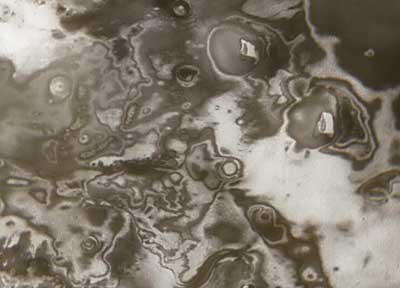Making Astronomical Art with Your PC

Mars Global Surveyor Image:
Spring Thaw in Northwestern Planum Australe
Saturday I taught the first of a two part four hour class on astronomical image processing at the Adler Planetarium. The class, No Telescope, No Camera? No Problem: Making Astronomical Art with Your PC covers locating and downloading planetary and astronomical image data from the Internet and then using various image processing techniques to create finished pictures.
The first session covered both the basics of image processing and manipulation with Adobe Photoshop and how to use these techniques to transform raw PDS (Planetary Data System) image files into attractive colorized pictures. An added bonus was that these techniques are also applicable to the processing of images produced by digital cameras. The class consisted of both a lecture component and a demonstration component. Images used during the class were all downloaded from NASA JPL PDS Missions site.
For the demonstration component of the class, I demonstrated the following techniques:
- contrast enhancement and colorization of a single Viking Lander image of the Martian surface
- combining separate red, green, and blue Viking Lander images in order to produce a color picture while employing the contrast manipulation techniques previously illustrated
- combining red and blue filter images from the Mars Global Surveyor Wide Angle Camera and synthesizing a green channel to create a color picture
- using a Galileo image of asteroid Gaspra to explain enlarging and sharpening.
For some of the techniques, I showed that there was more than one way to get the job done and that the choice of methods really depended on the picture that was being worked. There was a lot of ground to cover and the class ran longer than its scheduled two hours. In addition to using Photoshop, I used both GIMP (with the PDS plug-in) and NASAView software to demonstrate how to open PDS image files and save them in standard graphics formats.
One of the exercises was to create a color picture of Mars by combining the image data from two Mars Global Surveyor Wide Angle Camera images: one taken using the blue filter, the other using the red filter. A small section of that picture is shown above. For purposes of comparison, you can compare this image with the Spring Thaw in Northwestern Planum Australe version posted on the Malin Space Science Systems web site.
Part two of the class will be held this Saturday and will cover the processing of astronomical images stored in the FITS (Flexible Image Transport System) format. For a list of this and other classes currently available from the Adler Planetarium, visit their classes page.
| Return to the Blog Index | This entry was posted on Monday, January 28th, 2008 at 10:13 am and is filed under Astronomy, Photoshop, Space Art.